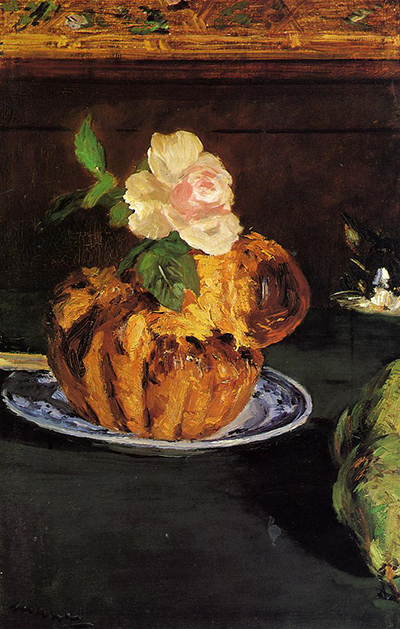The French Realist and Impressionist painter Edouard Manet painted the oil on canvas piece, Still Life with Brioche, in 1870. It is widely acknowledged that the piece was inspired by Jean Siméon Chardin, known for his mastery of still life paintings.
Chardin had donated his painting, La Brioche, also surrounded by sensual objects, to the Louvre, and Manet became inspired upon observing it. Chardin tops his brioche with a white and green clematis flower and surrounds it with apples, cranberries and a decanter of red wine, as though in a festive scene. With the pinkish red colours and juicy fruits, Manet, like Chardin, provides a sensual image, but he, instead, gives the impression of a sort of gentle feminine decadence.
Manet's Still Life with Brioche depicts a brioche atop a fringed white cloth as its centrepiece. A pink rose, so pale that it is almost white, is placed on top of the brioche, instantly creating a romantic atmosphere, and the brioche is surrounded by fresh fruits and other objects. Continuing the theme of feminine delicacy, four large, round, pale peaches are placed directly touching the brioche, while a bowl of succulent purple plums glistens in the background. A bunch of ripe-looking green grapes is in the foreground. To awaken the visual senses, a bright red box decorated with a gold design is placed to the left of the brioche. It bulges open, although its contents are invisible. A knife is on the table, perhaps in preparation for the brioche to be cut, and the table itself has flamboyant 18th century Rococo carvings on the front.
The inclusion of such a table (with this particular design) is said to be Manet's way of paying homage to Chardin, although it also adds to the decadent atmosphere. As well as catering to the different senses, Still Life with Brioche also plays with the concept of light and darkness. The importance of the tasseled white cloth, upon which the brioche is placed, becomes clear. The entire picture would be shadowed, were it not for this fabric, which completes the feminine motif. It does this by creating an image of purity, while drawing the viewer's eye constantly back to the subject of the painting, the darkly shaded, yet deliciously buttery brioche. As in all of his many still life paintings, no object is superfluous. Manet expertly engages viewers in every aspect of what he has painted, while giving a clear reminder of the reason why he has named his painting Still Life with Brioche.




